Comtess De Busho - the subtleties of growing liana-like clematis
When you look at Clematis Comtesse De Busho, no one will remain indifferent. This large-flowered liana-like shrub is striking in its appearance and does not imply any particular difficulties in care, for which it is so appreciated by many gardeners. Even a person without experience is quite capable of achieving success in growing a crop, if he adheres to certain norms of agricultural technology.
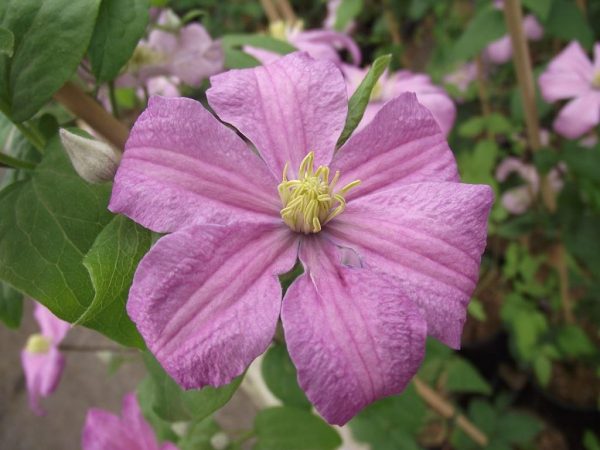
Comtesse de boucher clematis
general description
Clematis Comtesse de Bouchaud is the result of the work of the French breeder Francis Morel, obtained at the end of the 19th century. In the common people it is also called "Countess De Boucher" in honor of a high-ranking lady who at that time owned a large garden in Charles.
The perennial shrub has an active growth - the maximum height reaches 3-4 m.However, due to the weather conditions in Russia, the indicators are more modest - in general, the liana does not exceed 2-3 m.
The shoots are densely leafy, covered with dense complex-shaped leaves, consisting of 5 pointed-ovoid segments.
The bush forms buds on vegetative shoots of the current season. The flowers are quite large in size, reaching 10-15 cm in diameter. The petals are pale pink with a lilac or lilac shade, with a slightly corrugated surface and slightly curved edges. Anthers with bright yellow stamens are located in the center.
It enters the flowering phase at the end of June and continues to delight with its appearance until September. A distinctive feature of this hybrid variety is the formation of flower ovaries practically from the base, which sets it apart from other representatives of this culture.
Landing features
Despite the unpretentiousness of clematis, planting it in open ground should be approached with responsibility, due to the ability of a flower to grow in one place for up to 20 years without the risk of losing its decorative effect.
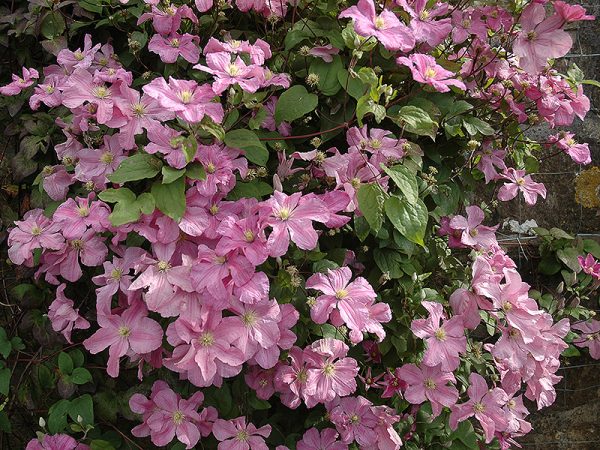
Clematis Comtesse de Boucher photo and description
Timing
The best time for the event is spring (late April-early May), especially when cultivating a plant in an area with a harsh climate.
Planting in the fall is also permitted. In this case, it is recommended to start work in September-October, at least 30 days before frost.
Seat selection
This variety is not subject to fading in direct sunlight, therefore, the shrub can be placed both in well-lit corners of the garden and in partial shade. In this case, you will have to take care of protecting the bush from the effects of drafts and gusts of wind.
When placed next to a garden building or a fence, you should maintain a step of 0.5 m. This will provide the necessary level of insolation and exclude excess moisture from the structures after rain.
Another important point is the occurrence of groundwater.When they are close to the surface, an artificial embankment with a height of at least 15 cm is constructed in order to prevent possible decay of the root system.
Experienced gardeners advise preparing the planting pit in advance, about 2-3 weeks in advance. At the bottom of the deepening, a drainage layer of expanded clay or gravel is necessarily distributed, a soil mixture is partially poured over it. In addition to garden soil, the substrate should contain either ash in the case of an acidic environment, or needles or sawdust if it is necessary to leach the soil.
Additionally, compost, plant humus or mineral complexes are added to the hole to increase soil fertility. The use of fresh manure before direct planting is strictly prohibited; it is allowed to apply it only in the previous season a few months before the procedure.
Seedling preparation
A healthy seedling:
- there are no traces of mechanical damage and disease;
- elastic roots (at least 5 pcs.) about 0.5 m long;
- on shoots 5 cm high, there are at least 2 growth buds.
If the roots of the plant, along with the earthy clod, are too dry to restore elasticity, they are placed in water for several hours.
Landing technology
- Dig a planting hole with a depth and diameter of 0.6 m. When planting, a group of shrubs maintain the distance between the holes, taking into account their dimensions in an adult state.
- A drainage cushion is made of chipped bricks, pebbles, expanded clay or crushed stone.
- Fall asleep with a partially prepared soil mixture, forming a mound.
- Stick in the support. If this is done at the end of the process, the risk of injury to the plant's root system increases.
- Disinfect the ground with a weak solution of potassium permanganate.
- A seedling is installed in the middle, the roots are straightened.
- The remaining space is covered with soil. At the same time, a small recess about 10 cm deep is left, which is gradually filled with a substrate throughout the season.
- Watering. Mulch.
Care
Watering
Clematis have a positive attitude towards frequent soil moisture. Irrigation is worth taking into account the weather conditions of the region.
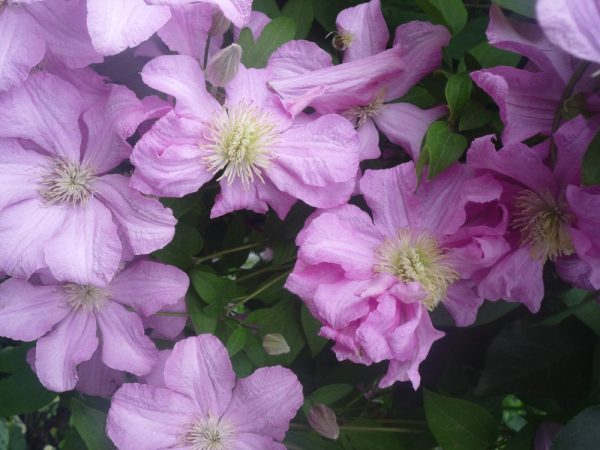
Clematis Comtesse de Bouchot description
With moderate climatic indicators, the shrub is watered once a week, during the heat, the time interval is reduced by 2-3 times. In this case, it is recommended to apply the liquid not only under the root, but also to spray it with the aerial part of the plant.
Top dressing
If the required amount of fertilizer was applied during planting, there is no need to additionally feed clematis in the current season.
A year later, the shrub begins to be fertilized with a frequency of 1-2 times a month, alternating with organic matter and mineral complexes. They stop feeding the liana with phosphorus-potassium preparations at the end of September, nitrogen - in the middle of summer.
Mulching
Mulching the near-stem space keeps the soil moist and protects the root system from overheating and hypothermia, and also stops the growth of weeds.
Peat, sawdust, crushed tree bark or plant residues are taken as consumables. It is not recommended to use straw for these purposes, because it attracts rodents to the plant.
Pruning
Comtesse De Boucher belongs to the third group of pruning, which involves a cardinal haircut before the onset of cold weather. In regions with a harsh climate, the branches of a plant are usually cut off at the base, in areas with a temperate and warm climate, 2-4 growth nodes are left. In this case, the cut is placed directly above the kidney.
Additionally, damaged and wilted segments are completely removed during the entire growing season.
Shelter for the winter
At the end of the autumn pruning, the vine is covered. First of all, the periosteal circle is covered with a sufficiently dense layer of mulch made of vegetable humus or peat, after which a wooden box is installed.Spruce branches or leaf litter are distributed on top and covered with agrotextile.
In the spring, such a shelter must be removed in time so that Clematis does not suffer from overheating. It is better to do this in stages over several weeks, first removing the artificial turf and only then freeing the soil from old mulch.
Reproduction
For reproduction, clematis adhere to the vegetative method. Seed is suitable only for natural forms, because the characteristics of the mother plant are not preserved in the bred specimens.
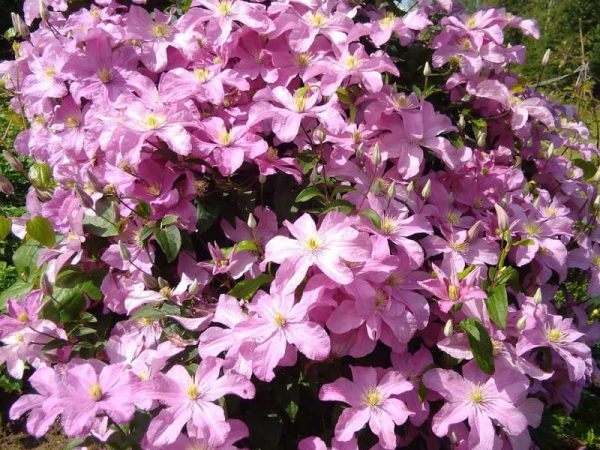
Clematis variety Comtesse de Boucher
Cuttings
One of the easiest and most productive ways to get several flowering vines at the same time. As an initial plant, specimens are taken at the age of 3-4 years. A part of the apical shoot about 5 cm in length with the presence of 1-2 pairs of buds is cut off from them. Preference should be given to the segments located in the inner part of the crown.
After pruning, the bottom of the cutting is treated with a growth stimulant and embedded in a moistened mixture of sand and peat. To speed up the process of root formation, polyethylene is pulled over the container, thereby creating a greenhouse effect.
Dividing the bush
Allowed only for reproduction of vines over the age of 5 years. An event is held in spring or autumn, during the procedure, part of the rhizome is digged in with a shovel, after which the plot is moved to a new place. Additionally, it is recommended to disinfect the injured segments with a solution of potassium permanganate or any fungicidal agent.
Layers
The option involves dropping vegetative shoots near an adult plant. To do this, make a small hole about 10 cm deep, to which the branch is bent and sprinkled with earth. For greater efficiency and speed up the rooting process, the shoot is slightly cut in the place where it will be in the soil.
The resulting seedling is separated from the mother bush in the next season, until that time it is provided with the standard care for Clematis.
Diseases and pests
Liana-like Comptess De Boucher is practically not exposed to diseases and attacks of insects. However, in rare cases, the gardener may encounter a number of problems that are best solved at the first symptoms.
| Problem | Signs | Prophylaxis | Treatment |
| Rust | Reddish raised spots / strokes on the inside of the leaves, from the outside they look like yellowish blotches. Leaf plates dry up, fall off. | They keep the site clean, remove plant residues in a timely manner, treat with fungicides, adhere to agrotechnical standards. | Folk remedies: dissolve 1 tablet of aspirin in 4 liters of water, 1 tablespoon each. sunflower oil and soda, 1 tsp. dishwashing detergents (sprayed every 7 days). Purchased preparations: Baktofit, Bordeaux liquid, Cuproxat, Medex, Cumulus, Vectra, Strobi, Azofos, Penkoceb. |
| Viral mosaic | Irregular spots from pale yellow to deep green, stunted development, young shoots and leaves dry out. | When planting, adhere to the recommended scheme, prevent the active growth of weeds, use disinfected tools for pruning, | When a disease occurs, the culture is completely destroyed by burning, because there are no effective means to combat mosaics. |
| Wilt | With a slow progression of the disease, the surface between the veins of the leaf plates acquires a brown tint. Over time, the spots spread over all the leaves, the plant stops in development, the shoots lose their elasticity and bend in an arc. | The soil is disinfected before planting, periodically treated with Agate or Trichodermine. They adhere to watering regimes and dosage of nitrogen-containing preparations. Do regular weeding and loosening. | At the initial stage, Fundazol, Benlat, Topsin-M, Vectra are used. With a large-scale lesion, the plant is disposed of. |
| Powdery mildew | Plaque of white color with protruding drops, primarily manifests itself on the lower parts of the shrub. | Moderately apply nitrogen fertilizers, prevent waterlogging of the substrate, carry out sanitary pruning in a timely manner, spray with fungicides or Bordeaux liquid. | All affected areas are removed, the crown is abundantly irrigated with fungicidal preparations, while capturing the soil. System tools: Quadris, Amistar extra, Purest flower BAU 700, Skor, Vitaros, Tiovit Jet, Topaz. |
| Gray rot | Gray dusty bloom of a fluffy texture, loss of turgor and typical color by leaf plates, rapid fading. | They adhere to moderation in watering, avoiding excessive waterlogging. Refrain from crowding plantings and thickening of the green mass. | In the spring, they are treated with a solution of Bordeaux liquid. |
| Nematode | The plant lags behind in growth; in hot weather, the leaf plates curl. | Calendula officinalis, marigolds, rudbeckia are planted nearby. promptly dispose of plant residues after weeding, adhere to the recommended rates for irrigation. | Nemaphos, Dimethoat, Vidat, Nematofagin |
| Spider mite | Thin pale cobweb on the seamy side of the leaf plates, whitish blotches. | Avoid overdrying the soil (mites are more common in dry climates), sprayed with garlic infusion. | Iskra-Bio, Kleschevit, Tiovit-Jet, Fitoverm, Fufanon-Nova. |
| Aphid | Leaves curl, buds and stems are deformed, there is a suspension of growth, a sticky bloom on the surface. | They attract hoverflies to the garden by sowing carrots, fennel, parsley, dill on the territory. Pots of sawdust are placed on flower beds to attract earwigs that feed on aphids. In the process of feeding, a balance is observed, the insect prefers to settle on overfed or weakened crops. | Folk remedies: infusion of onions, garlic, hot pepper, tomato tops, tansy, wormwood, tobacco. Purchased preparations: Biotlin, Tanrek, Alatar, Fufanon, Eforia, Tiara, Confidor, Doctor, Iskra Zolotaya, Bison. |
Use in landscape design
In landscape design, the Comtesse De Busho variety can be used as an element for vertical gardening of any building: a gazebo, a fence, a residential building, an arch. Clematis also looks great near old trees or in a group with other decorative flowers, such as climbing roses.
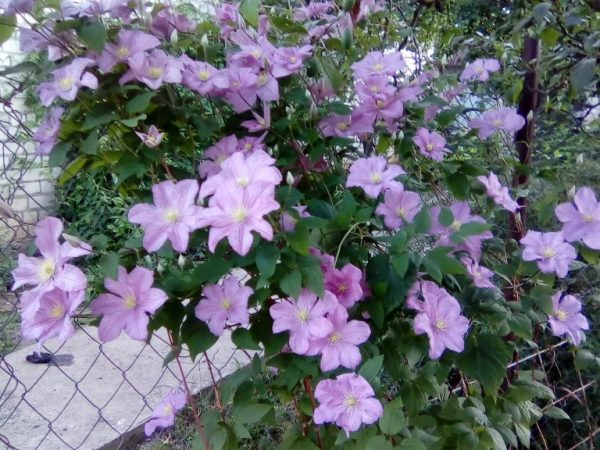
Clematis Comtesse De Bouchot
Variety reviews
This variety of clematis is one of the favorite among gardeners. The popularity of the shrub is due to its excellent vitality, high frost resistance and extremely low maintenance requirements. Also, an important role is played by the external characteristics of the culture, which pleases its owners with abundant gorgeous flowering over a long period.

